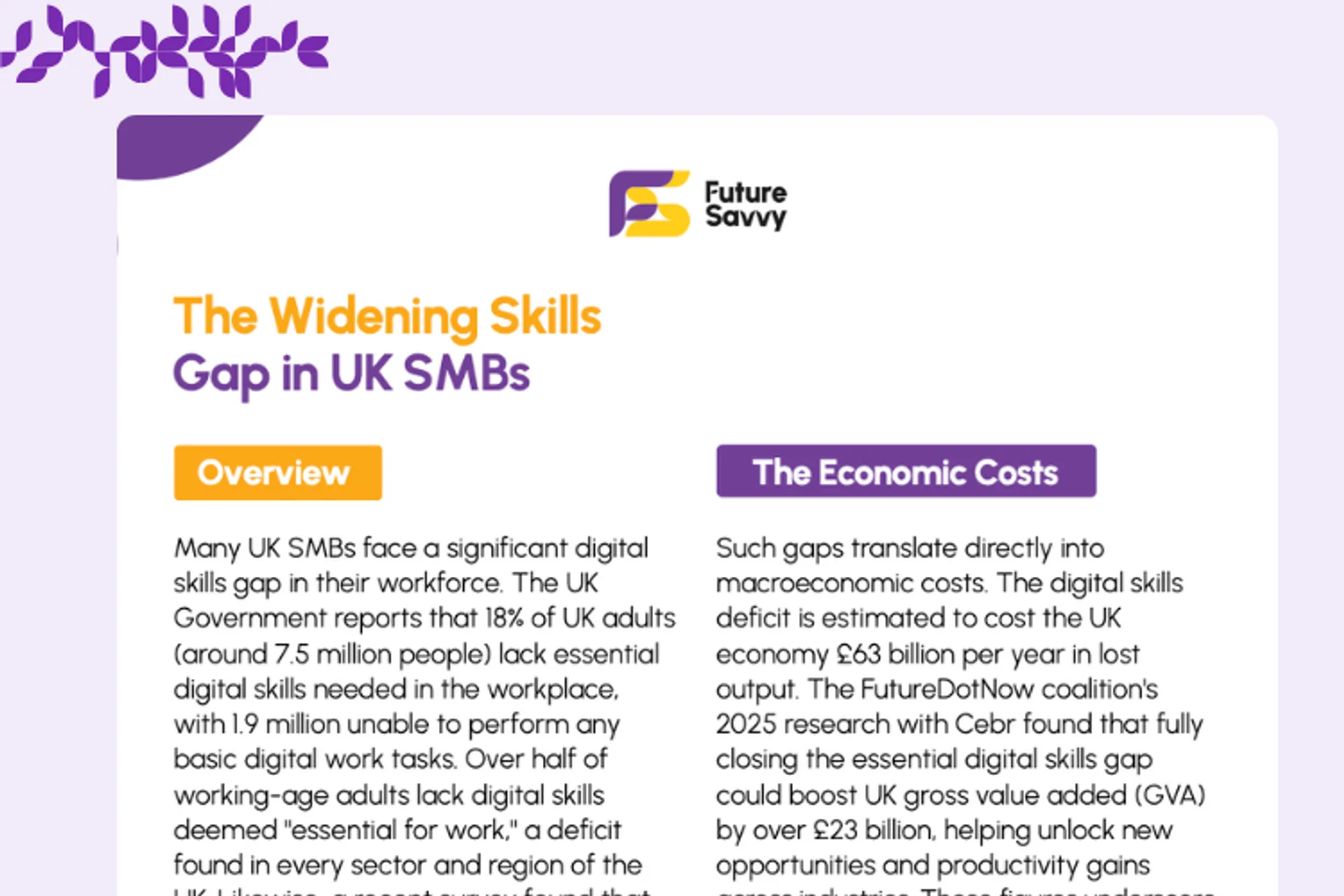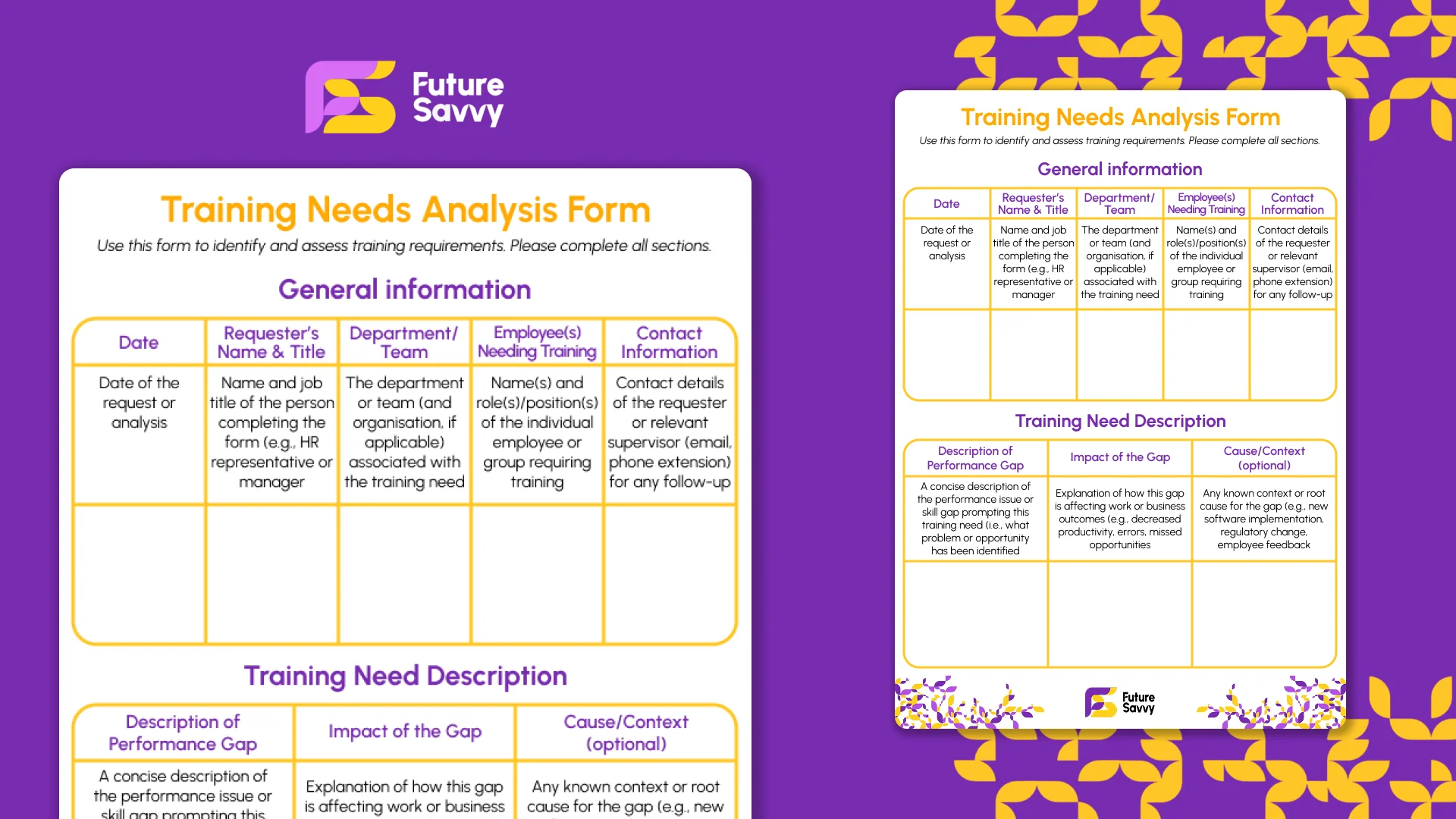- L&D INSIGHTS/
- 6–12%: The Productivity Boost: The Real ROI From Reskilling & Upskilling/


6–12%: The Productivity Boost: The Real ROI From Reskilling & Upskilling
- L&D INSIGHTS/
- 6–12%: The Productivity Boost: The Real ROI From Reskilling & Upskilling/
6–12%: The Productivity Boost: The Real ROI From Reskilling & Upskilling
What if one small investment could boost your team’s productivity by 10% in just a few months? Recent studies suggest that well-targeted reskilling and upskilling programs can deliver surprisingly quick gains in output, often paying for themselves in a matter of weeks.
This article unpacks the compelling business case for reskilling and upskilling primary drivers of growth and efficiency. Drawing on data from our recent white paper, it reveals how targeted skills investment can deliver a 6–12% productivity boost, often within months. It explores the mechanisms behind this gain, provides a practical framework for making talent decisions, and includes a worked example of the financial payback.
In short, investing in your employees’ skills may be the closest thing to a “quick win” for productivity and talent retention in today’s challenging market.
Background & Evidence
The current business landscape presents a clear challenge. Nine out of ten UK employers report struggling to recruit the talent they need, forcing them into costly bidding wars for scarce skills. For SMBs, this external talent market is often unsustainable. The alternative - building talent from within - is proving to be a far more effective strategy.
What Does the Data Say
Our new white paper, The Impact of Skills Underinvestment on UK SMBs, consolidates extensive research to quantify the return on this strategy. The findings are compelling:
- Effective reskilling initiatives typically boost employee productivity by 6–12%, with tangible results often appearing within months of the training.
- Approximately 75% of these reskilling programmes deliver a positive Return on Investment (ROI) for UK employers, making it one of the most de-risked investments a business can make.
This isn't a theoretical gain. The productivity boost comes from concrete, operational improvements. When employees are properly trained, they master the tools they use every day -- from CRM systems to data analysis software like Microsoft Excel or Power BI. This proficiency leads to faster task completion, fewer errors, and the standardisation of efficient workflows across the team
The Employees’ Perspective
Employees echo his sentiment: 94% say they would stay at a company longer if it invested in their career development. As Paul Turner, Vice President at CIMA, recently emphasised, “Investing in relevant training … is essential to empower employees and drive productivity”.
In practice, better-trained employees not only get more done – they’re also more engaged and less likely to leave for greener pastures. These outcomes make intuitive sense. Upskilling helps staff fully leverage the tools and technology you’ve already invested in, standardises best practices across teams, and instils a culture of continuous improvement.
For a deeper dive into these findings - including industry-specific insights and ROI calculation tools – read Future Savvy’s “The Impact of Skills Underinvestment on UK SMBs” white paper.
Download our White Paper: The Impact of Skills Underinvestment on UK SMBs
Download now
Analysis and Discussion
The root cause of productivity drag in many SMBs is not a lack of effort but a gap in capability. Teams are often working hard but inefficiently, hampered by inconsistent processes and software that is powerful but poorly understood. Over half of business leaders admit their teams aren't using existing technology to its full capacity due to limited skills.
Addressing this requires a strategic approach to talent development. For SMB leaders, the core decision often comes down to a simple question: do we build the skills we need internally or buy them from the external market?
Build vs Buy: A Quick SMB Framework
For most UK SMBs, the “build” approach of reskilling from within is faster and more economical: you tap into people who already understand your business, avoid expensive recruiter fees, and reinforce loyalty by investing in your team. Reskilled internal candidates usually don’t demand the premium salaries that outside experts command.
The “buy” option – hiring for skills – is sometimes necessary for niche needs, but it’s often hard to find and costly. For example, external hires come at a~20% higher salary on average. Hiring also entails onboarding delays (a new employee can take months to get up to speed in a role).
When a skills gap appears, use these four criteria to guide your decision:
- Urgency: How quickly do you need this skill to be fully operational? Extremely high urgency might favour hiring an experienced professional (buy).
- Role Specificity: How much deep company or client knowledge is required for success in the role? The more specific the context, the stronger the case for upskilling an existing employee (build).
- Cost: What is the total cost of acquisition? External hires come with recruitment fees and often a 20% salary premium for in-demand skills, compared to the more contained cost of a targeted training programme.
- Capability Runway: Does an internal employee have the aptitude and ambition to grow into the role and beyond? Investing in them (build) fosters loyalty and creates a future leader.
Overall, building talent from within tends to be the low-risk, high-return bet for closing most skills gaps, while buying talent is best reserved for when you truly need fresh expertise that you can’t develop internally.
Quick ins
Even without a big training budget, there are practical steps to start reaping the benefits of upskilling. SMB leaders can consider these low-effort, high-impact actions:
Integrate short (5–15 minute) online lessons or tips into the work week. Bite-sized learning – for example, a weekly video on an Excel or CRM feature – helps employees continuously upgrade their skills without taking significant time away from work.
Identify your tech-savvy or process-guru team members and encourage them to coach others in short sessions. A culture of peer-to-peer learning (such as “lunch and learn” workshops or pairing less experienced staff with expert mentors) spreads best practices quickly and at virtually no cost.
Take a fresh look at your Standard Operating Procedures for common tasks. Updating these SOPs to reflect current best practices and software capabilities – and training everyone on the new standards – is a quick and easy way to upskill your staff. Even a simple step like standardising how data is entered or reported can save each employee minutes a day, preventing errors and confusion.
Empower teams with simple dashboards or metrics tracking their own performance. For instance, a sales team that can clearly see their response times or a factory team seeing real-time quality metrics are more likely to spot skill gaps and process bottlenecks. Use these dashboards to highlight areas where training could improve key metrics, creating a positive feedback loop between learning and performance.
Sample Budget & Payback
Let's translate the 6–12% productivity gain into a tangible financial scenario.
Imagine a team of 25 employees who rely heavily on a core software tool, like a CRM or a data platform. You invest in a blended learning programme at a cost of £400 per employee, for a total investment of £10,000.
As a result of the training, each employee becomes more proficient, saving an average of just 20 minutes per day. This is a conservative productivity uplift of around 6% (assuming 6.5 productive hours daily).
Here’s the simple payback calculation:
- Time saved per day: 25 employees x 20 minutes = 500 minutes, or ~8.3 hours.
- Value of time saved: Assuming an average loaded wage of £25/hour, that’s over £207 of productive time reclaimed every single day.
- Weekly return: £207/day x 5 days = £1,035 per week.
- Payback period: Your initial £10,000 investment is fully paid back in less than 10 weeks.
This rough payback calculation doesn’t even count qualitative benefits like improved accuracy or happier employees, but it shows how quickly reskilling and upskilling can translate into bottom-line impact. Many UK SMBs report similar results: a modest training investment leading to noticeable efficiency gains within a single quarter.
Mini Case Example: A Logistics Firm in the Midlands
A 40-person logistics company in Birmingham was struggling with inaccurate delivery forecasting and high administrative overhead. Their planning team spent hours manually compiling data in spreadsheets, leading to frequent errors and delays. Staff morale was low, and two key analysts were actively looking for new roles.
Instead of hiring a new data scientist, the Operations Director invested in an advanced Excel and Power BI training programme for six members of the planning team. The total cost was under £3,000. Within two months, the team had automated their core reporting dashboards. This cut report generation time by 90 minutes per person, per day- an immediate productivity gain of over 10%. Forecast accuracy improved, reducing costly last-minute shipping changes.
Crucially, the two analysts who had been job-hunting became highly engaged, taking the lead on the new data projects and deciding to stay with the company. The investment paid for itself in seven weeks and prevented the £60,000+ cost of replacing two experienced employees, as the average cost to replace a single employee in the UK is estimated to be around £30,600 (link to article 2).
Want to avoid the costs of replacing valuable employees? Future Savvy’s instructor-led training courses can contribute towards the success of your reskilling and upskilling efforts. Check them out today!
For UK SMBs, the path to enhanced productivity and resilience runs directly through your people. Underinvesting in skills is a strategic gamble that results in inefficiency, higher staff turnover, and a gradual loss of competitive edge.
The evidence is clear: proactive reskilling and upskilling are high-leverage investments. We’ve seen that even a short upskilling initiative can drive a 6–12% jump in productivity – often within the same quarter – and that roughly 75% of such efforts pay back more than they cost.
Ready to build your own business case for upskilling? Download our comprehensive white paper, The Impact of Skills Underinvestment on UK SMBs, for the full methodology, ROI calculators, and actionable templates to get started.
Related Articles

Digital skills gap: £63bn a year hit for UK SMBs
UK SMBs collectively lose £63bn a year to the digital skills gap - about £3,800 per employee - driven by countless small inefficiencies. The article pinpoints three drains: process inefficiency, errors and rework, and underused software and illustrates gains via a case study where targeted enablement improved billable hours and cut rework. It recommends a pragmatic 90-day plan: audit key workflows, deliver focused training with “digital champions,” then track ROI and bake improvements into SOPs.

Why Staff Turnover in the UK Is Spiking
The article explains that UK SMBs are facing costly first-year staff turnover, largely due to underinvestment in employee skills rather than bad luck. It breaks down the true cost of churn - hiring, onboarding, and long ramp-up times- and shows how structured training, 30-60-90 day learning paths, and better onboarding can dramatically improve retention, productivity, and profitability. Using concrete maths, a hotel case study, and practical KPIs, it gives leaders a framework to calculate their own churn costs and build data-driven training programmes that keep employees longer.

Training Needs Analysis Form
This fillable Training Needs Analysis (TNA) form helps teams identify and assess training requirements while capturing core request details (date, requester, team, employees). It walks you through defining the performance gap and its impact, aligning the need to business goals, comparing current vs. desired skills, and setting clear learning objectives with success criteria. You’ll also specify preferred delivery format/provider, timeline and priority, budget/resources, and define success metrics, evaluation, and approvals - so every request becomes a measurable, accountable plan.